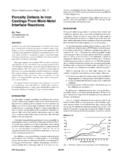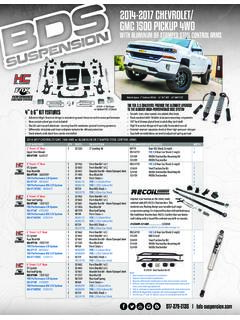Transcription of Formation and Control of Lustrous Carbon Surface Defects ...
1 1 AFS Transactions 02-154 SILVER ANNIVERSARY PAPER Division 4 Molding Methods and Materials Formation and Control of Lustrous Carbon Surface Defects in Iron and Steel Castings R. L. Naro ASI International, Ltd, Cleveland, Ohio Copyright 2002 American Foundry Society ABSTRACT This silver anniversary paper will up-date the original Lustrous Carbon research paper published in 1977 that described Lustrous Carbon Defects and their Formation as well as examined remedial techniques to eliminate Defects in gray iron castings. This updated paper examines new phenolic urethane binder technology and compares Lustrous Carbon defect susceptibility to older systems. The Lustrous Carbon forming tendencies of 2002 phenolic urethane no-bake binders are compared to furan and ester cured phenolic no-bake binders. New methods for defect elimination include the venting and vacuum exhausting of mold gases during pouring.
2 In addition, Lustrous Carbon Formation in steel castings is examined and suitable methods to eliminate defect Formation are discussed. Current standard cold-box binder formulations provide virtually identical gray iron casting results compared to the 1977 research. Cold-box binder systems formulated with new, less volatile solvent systems (biodiesel or vegetable oil-based solvents) showed significantly reduced tendencies for Lustrous Carbon Formation . Furan and ester cured phenolic no-bake binders do not produce Lustrous Carbon Defects . Venting and application of vacuum during metal pouring were both effective in minimizing Lustrous Carbon wrinkling. Lustrous Carbon defect Formation is more likely to occur when low pouring temperatures and lengthy pouring times are used. Defects are eliminated by increasing metal pouring temperatures, pouring faster and incorporating red-iron oxide additions to sand mixes.
3 Incorporating percent red-iron oxide in the sand mixes also eliminates Lustrous Carbon Defects in steel castings. INTRODUCTION HISTORICAL BACKGROUND: The growth in both phenolic urethane cold-box and no-bake binders since 1970 has been phenomenal and is shown in Figure 1. Figure 1: Growth of phenolic urethane binders in the United States In early 1971, during the time of the initial Lustrous Carbon research, only million pounds of cold-box and no-bake phenolic urethanes were consumed by the foundry industry. When the original Lustrous Carbon paper was published in 21977, shipments of both cold-box and no-bake phenolic urethanes had grown to million pounds - an astounding figure at the time. During the first year of this millennium, 150 million pounds of both resins were consumed in the United States. Estimated worldwide use is generally considered to be over 300 million pounds. Shortly after the introduction of cold-box phenolic urethane binders, casting Defects , generally described as severely wrinkled surfaces Defects , were reported by some of the early users of these binders.
4 A few foundries also reported "leakers" in pressure-tight castings. The technical literature of the time contained little information regarding the specific conditions that increased the likelihood of these Defects , soon to be known as Lustrous Carbon , or methods to eliminate these Defects . The available information suggested that defect Formation is affected by pouring time and gating system design. Slow, turbulent filling and low pouring temperatures were reported to aggravate defect Formation . (Clifford, ). Lustrous Carbon Surface imperfections were often referred to as "resin"; "kish" and "soot" Defects , as the name " Lustrous Carbon " wasn't commonly used to describe these Defects . The Defects almost always occurred when using binders that evolved large quantities of carbonaceous decomposition products during the filling of the mold by molten metal. Such carbonaceous residues, however, can be beneficial when present in lesser amounts, as they provide a reducing atmosphere that minimizes oxidation at the mold-metal interface and generally improves casting Surface finish and peel.
5 In steel castings, particularly those with thick sections, pockmarking may appear on casting surfaces . In high-alloy steels, such as stainless steel and nickel-base alloys, appreciable amounts of Surface porosity and Carbon pickup might occur; both are undesirable. Lustrous Carbon Defects have also become one of the major problems in lost foam castings. (Moll, N.) Lustrous Carbon Defects usually appear on castings as areas containing wrinkled, shiny surfaces , which often resemble cold shuts or seams. The appearance of these wrinkled or lapped areas has often been compared to that of elephant skin, alligator skin or crows feet. Usually the Defects occur on external surfaces but can also form on cored surfaces of hydraulic cylinders, boiler sections and pumps. In thin casting sections, Lustrous Carbon accumulations and entrapment can result in hydraulic unsoundness as well as sub- Surface "cold shut" Defects .
6 Thick metal sections have been reported to be less prone to Lustrous Carbon Defects than thin sections. Under certain conditions, Lustrous Carbon Defects may result in sub- Surface blistering or Surface laminations. Typical Lustrous Carbon Defects found in a few gray iron industrial castings are illustrated in Figure 2. a: Wrinkles on automotive brake caliper b: Blister on disc brake rotor c: Surface lamination on disc brake d: Surface wrinkles on pully hub e: Surface wrinkles in oil pan which f: Surface wrinkling on lost foam truck leaked transmission part Figure 2: Examples of typical Lustrous Carbon Defects in industrial castings. Microstructural examination of areas containing these Defects often reveals discontinuities extending deep into the casting body.
7 Figure 3 illustrates typical Lustrous Carbon Surface pockmarking Defects found in heavy section steel castings. 3 Figure 3: Surface pockmarking on steel casting Lustrous Carbon Defects can occur with many binder systems. The Defects can form with oil-alkyd-isocyanate no-bake binders, cold-box and no-bake phenolic urethane binder systems, certain grades of furfuryl alcohol, urea-furfuryl alcohol (furan) no-bake binders and phenolic shell-sand systems (Wragg, Greenhill, Clifford, Behring). Lustrous Carbon related Surface Defects are not peculiar to the chemically curing binder systems; they also are commonly found on castings made in green sand molds containing large amounts of seacoal (Kvasha, Bindernagel, Petrela, Beale, Draper). BINDER DEVELOPMENTS 1977 to 2002 The phenolic urethane binder system consists of no-bake and gas cured resins. Part 1 is a phenolic resin (poly-benzylic-ether-phenolic resin) diluted approximately 50 percent with solvents.
8 Part 2 is a polymeric di-isocyanate resin diluted with approximately 25 percent solvents. The solvents can be composed of aliphatic, aromatic or vegetable oil-based derivatives (Biodiesel), or various blends thereof. One of the primary purposes of the solvents is to reduce binder viscosity. Typically, the viscosities of the Part I and Part II resins are adjusted to 300 cps or lower to provide good pumping properties, rapid and efficient sand coating qualities and good flowability of mixed sand. Secondly, the solvents enhance resin reactivity and Control bench life. An amine-based catalyst is used as the curing agent for the no-bake binder while a gaseous amine (triethylamine or dimethylethyl amine) is used for the gas-cured binder. Although the general chemistry of phenolic urethane binders remains essentially the same as the system investigated in 1977, (Naro 1977) there have been numerous modifications in resin formulations involving both the phenolic base resin as well as the solvent system package.
9 The Part I phenolic base resin has been modified to reduce odor by reducing free formaldehyde levels. This is especially apparent when hot foundry sands are used. In addition, because of efforts to reduce solvent evaporation, the solvent system has been modified to incorporate higher boiling point solvents or new solvents systems with improved environmental properties (Biodiesel). Because these solvents remain entrapped in the binder film, the newer formulated binder systems might, in fact, be more prone to Lustrous Carbon Surface Defects . All current organic binder systems are based on the elements Carbon , hydrogen, oxygen, and in some cases nitrogen. The chemical makeup of phenolic urethane cold-box and no-bake binders, compared to other popular binder systems is shown in Table 1 (Chang). Table 1: Approximate chemical composition of cold-box and no-bake binders (Chang) Binder Type % Carbon % Hydrogen % Nitrogen % Oxygen PU Cold-box (1971) PU No-bake (1971) PU Cold-box (2002 standard) PU Cold-box (2002 biodiesel) (Biodiesel or vegetable-oil based solvents) PU Cold-box (2002 all aromatic) (All aromatic solvents) PU No-bake (2002 standard) Premium Furan No-bake (2002) Phenolic Ester No-bake (2002) At ferrous casting temperatures, the presence of these elements and their subsequent decomposition can produce a variety of 4casting Defects .
10 The following gaseous reactions are thermodynamically possible, and under the right conditions, might occur at the mold-metal interface (Naro 1999): Binder ----------- > H (nascent) -> H2 (g) Binder ----------- > N (nascent) ---> N2 (g) Fe + H2O vapor (binder) --------> FeO + 2H (nascent) 3 H2 (binder) + N2 (binder) > 2NH3(g) --------> 6H(nascent) + 2N(nascent) FeO + C (binder) ---------> CO (g) + Fe Although the first four reactions are likely to promote both Surface and subsurface porosity Defects , the last reaction usually results only in Surface Defects , such as Surface pockmarking or, more frequently, Lustrous Carbon laps and Surface wrinkles (Naro 1977). Clearly, many factors are involved in the development of binder-associated Defects . This paper will investigate, using the same tests developed in the early 1970s, how susceptible new binder formulations are to Lustrous Carbon Formation .








